NVIDIA Shield Review: At the Crossroads of PC and Mobile Gaming
by Brian Klug on July 31, 2013 12:14 AM ESTGPU Performance - 3DMark
The GPU performance story is finally a competitive one for NVIDIA. Although Tegra 4 lacks full OpenGL ES 3.0 compliance, it does finally dedicate enough SoC die area to GPU performance to compete with the likes of Apple and the iPad with Retina Display. We'll start with 3DMark, which is Android and Windows only at this point.
3DMark for Android features the Ice Storm benchmark and uses OpenGL ES 2.0. Ice Storm is divided into two graphics tests and a physics test. The first graphics test is geometry heavy while the second test is more pixel shader intensive. The physics test, as you might guess, is CPU bound and multithreaded. The overall score takes into account both graphics and physics tests. The benchmark is rendered to an offscreen buffer at 720p/1080p and then scaled up to the native resolution of the device being tested. This is a very similar approach we've seen by game developers to avoid rendering at native resolution on some of the ultra high resolution tablets. The beauty of 3DMark's approach here is the fact that all results are comparable, regardless of a device's native resolution. The downside is we don't get a good idea of how some of the ultra high resolution tablets would behave with these workloads running at their native (> 1080p) resolutions.
Here we see Tegra 4 in Shield outperforming all of the shipping players on Android, and virtually tying with Adreno 330 in Qualcomm's upcoming MSM8974 (Snapdragon 800 platform). Tegra 4's GPU performance is still no where near even Intel's HD 4000, but we're seeing massive improvements in raw FP throughput in ultra mobile GPUs. I'm very eager to see what's possible once Kepler makes its way into NVIDIA's mobile SoCs next year with Logan.
The 3DMark Physics test is also worth looking at as it shows a 36% increase in performance over four Krait 300 cores running at 1.5GHz. There are faster Krait 300s out there, but another 13% isn't enough to make up this gap. The Krait 400 comparison is much closer, but the Krait 400s have to be clocked at 2.3GHz to equal the performance of the 1.9GHz Cortex A15s. It remains to be seen which combination is ultimately lower power.
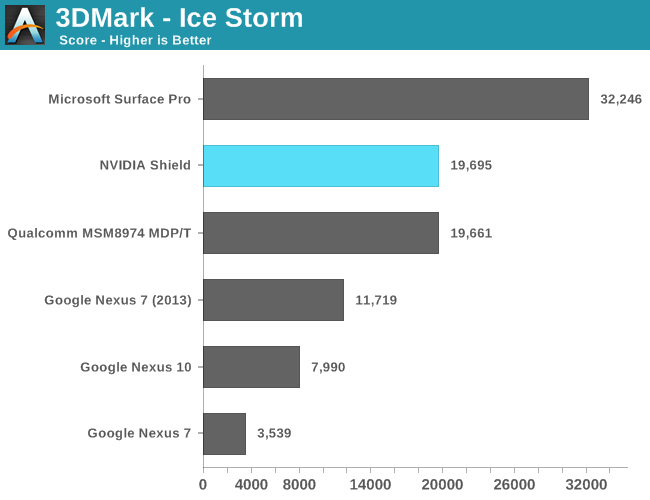

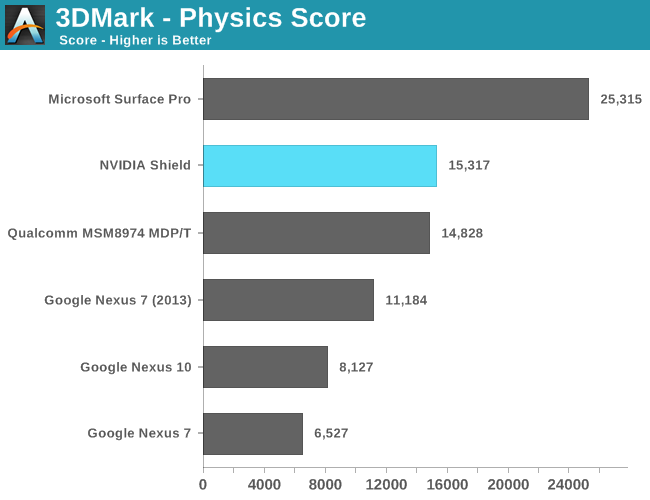
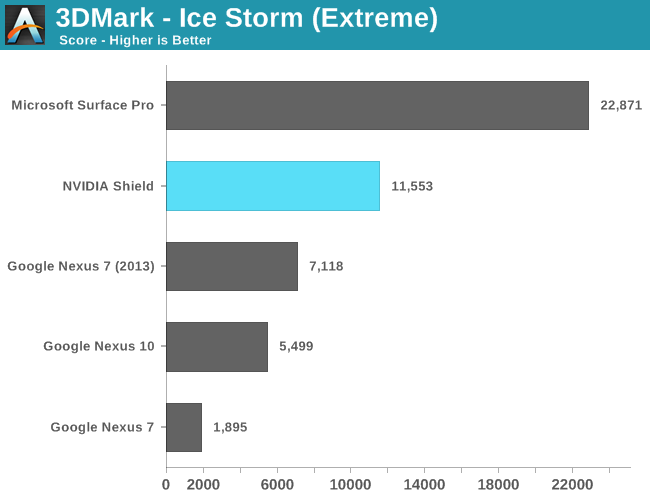
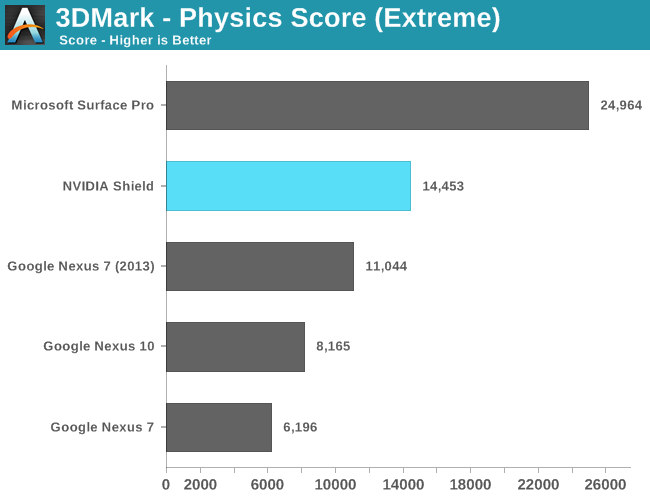

Basemark X
Basemark X is a new addition to our mobile GPU benchmark suite. There are no low level tests here, just some game simulation tests run at both onscreen (device resolution) and offscreen (1080p, no vsync) settings. The scene complexity is far closer to GLBenchmark 2.7 than the new 3DMark Ice Storm benchmark, so frame rates are pretty low.
In both tests, NVIDIA posts big gains over anything presently shipping from the Android camp. Adreno 330 pulls ahead on a level playing field, holding a 24% performance advantage over Tegra 4.
I would've loved to have seen this sort of competition from NVIDIA back when the iPad 4 launched, but it's at least good to see NVIDIA move from being a value player with Tegra 3 to a high performance contender with Tegra 4.
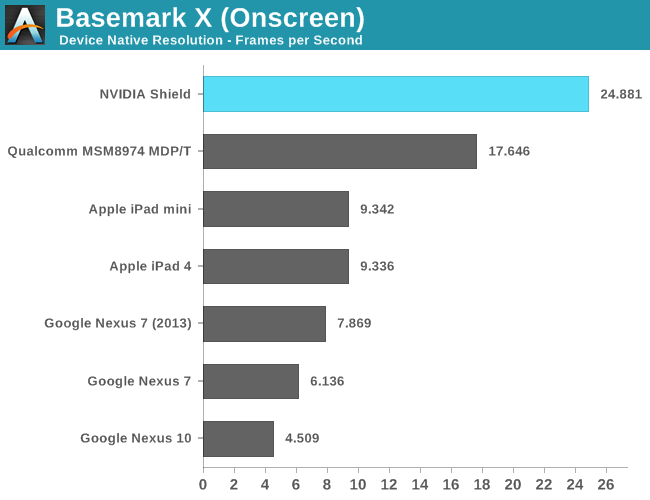











134 Comments
View All Comments
pancakes - Wednesday, July 31, 2013 - link
I heard they used Mini-HDMI because it's the most secure when moving the device around (via http://www.androidpolice.com/2013/07/30/nvidia-shi...VulgarDisplay - Wednesday, July 31, 2013 - link
I incredulously read the praise being heaped upon this device wondering what type of NDA had been agreed to for such an upbeat review of this odd and all but useless device and then I got to the end.I love the passive aggressive way of confirming what everyone already knows about the Shield, there is absolutely no reason to buy this over a smartphone. Don't worry guys, it offers minimal hitching and low latency when played on the toilet a room away from where your PC with no latency and a usable screen is sitting using up energy to stream games to a device that also uses energy. Oh, and don't forget that this brick with a fan is faster than a 10mm thick tablet that has a more usable screen that when paired with a ps3 controller would actually make a more portable gaming package.
So many of the uninformed are going to be extremely disappointed that the only way that the PC streaming will actually provide a good experience is by using it in the same house as the PC you are streaming from.
Cohaagen - Wednesday, July 31, 2013 - link
There is absolutely no reason to buy this over a smartphone?If you want a smartphone, this is the wrong device. But I'm searching for a fast device, which can handle all Android games now and the next few years and has a good battery life.
Even the actual Android-flagships Galaxy S4, HTC One and Xperia Z (both much more expensive than the Nvidia Shield) are slower than the Shield.... the PS3 controller not even counted in. Their battery life is worse.
Due to their 1080p-displays, their performance limit will be reached much sooner by more demanding games... the same goes for the new Nexus 7. I really like the decision of Nvidia, not to follow the ppi craze, 720p is perfectly fine for a gaming device with 5"-display.
Cohaagen - Wednesday, July 31, 2013 - link
Correction:Even the actual Android-flagships Galaxy S4, HTC One and Xperia Z (all of them much more expensive than the Nvidia Shield, the PS3 controller not even counted in) are slower than the Shield. Their battery life is worse.
chizow - Sunday, August 4, 2013 - link
Yes looking at some benchmarks around the Net, I didn't realize how fast this thing is. It's also significantly faster than the leaked Snapdragon S800 version of the Galaxy S4. Too bad Nvidia couldn't get Tegra 4's thermals under control, it's quite the performer.GrahamAudio - Wednesday, July 31, 2013 - link
Is there a camera?blanarahul - Wednesday, July 31, 2013 - link
The last line of the article pretty much sums up everything. I wish they would do something like Project Phoenix.ET - Wednesday, July 31, 2013 - link
Thanks for the review. The Shield looks like it right for my needs, and I'm glad it turned out to be well implemented. I might buy it at some point (if I have someone to bring it from the US), and finally get to play some of the PC games I don't get to play because my gaming time is usually away from my PC. Then again by that time I might be playing games such as Shadowrun Returns, Broken Age and Deus Ex: The Fall on my Nexus 7 and won't feel the need to buy it. And maybe, just maybe, Kainy will work well enough one day to provide decent PC streaming. Still, it's a tempting device for me.Heavensrevenge - Wednesday, July 31, 2013 - link
I REALLY hope they just say screw developing this too much to waste resources on it beyond now to beat this dead horse, I agree 100% Nvidia should mold this beast device into a super smartphone factor and rip Google Nexus' a new one.It's a cool device, but it's ~90% useless to ~90% of people (me included) .
So if they make a super kick-ass extreme battery life super-phone, I'd definitely buy one of those!
But Shield will never be in my wish-list of things to get ok Nvidia? If your reading this... Give us the best phones in a year or so and be done with this down-scaling prototype and get past this foreplay to the action of a beast phone which this thing dreams to grow up into.
JNo - Wednesday, July 31, 2013 - link
Sot it's of potential use to 10% of the population? That's still a huge market!What's with all the hate. Not every device has to have universal appeal. Those who see the value in it know who they are.